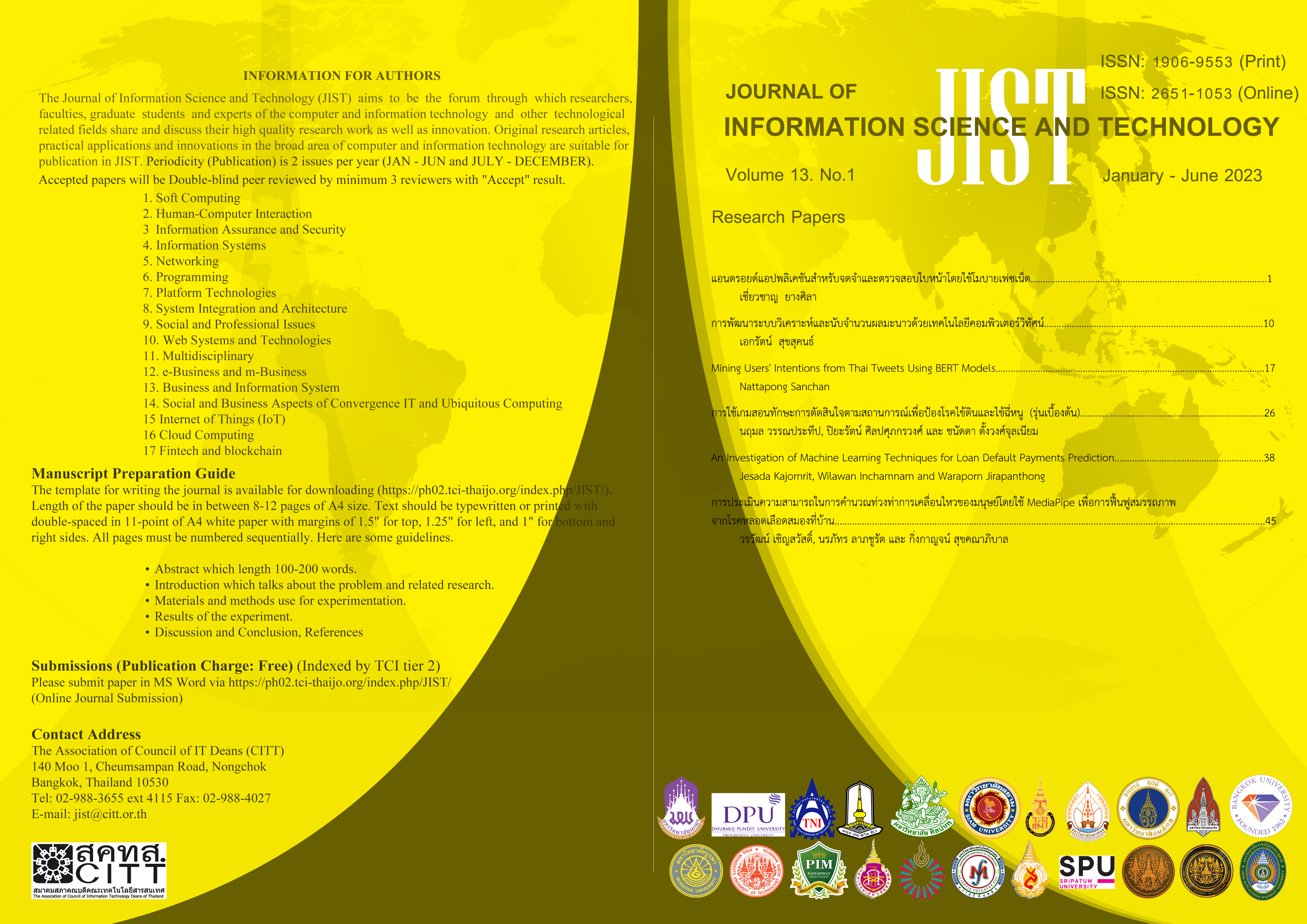Android Application for Face Recognition and Verification using MobileFaceNets
Main Article Content
Abstract
This paper presents the development of Android application for face recognition and verification using MobileFaceNets: a case study of the activity attendance check of staff at Roi Et Rajabhat University (RERU). The four objectives and their results in the study are as follows. 1) The developed Android application for face recognition and verification using MobileFaceNets was applicable to the activity attendance check of the RERU staff. 2) The Manhattan function had the fastest processing speed. 3) The researcher did a distance analysis for 100% accuracy and found that image A was identical to image B if the distance was <= 0.752 (Euclidean distance) or <= 5.796 (Manhattan distance) or >= 0.717 (Cosine Coefficient). 4) The efficiency analysis revealed that the application processing was 100% accurate.
Article Details
This work is licensed under a Creative Commons Attribution-NonCommercial-NoDerivatives 4.0 International License.
I/we certify that I/we have participated sufficiently in the intellectual content, conception and design of this work or the analysis and interpretation of the data (when applicable), as well as the writing of the manuscript, to take public responsibility for it and have agreed to have my/our name listed as a contributor. I/we believe the manuscript represents valid work. Neither this manuscript nor one with substantially similar content under my/our authorship has been published or is being considered for publication elsewhere, except as described in the covering letter. I/we certify that all the data collected during the study is presented in this manuscript and no data from the study has been or will be published separately. I/we attest that, if requested by the editors, I/we will provide the data/information or will cooperate fully in obtaining and providing the data/information on which the manuscript is based, for examination by the editors or their assignees. Financial interests, direct or indirect, that exist or may be perceived to exist for individual contributors in connection with the content of this paper have been disclosed in the cover letter. Sources of outside support of the project are named in the cover letter.
I/We hereby transfer(s), assign(s), or otherwise convey(s) all copyright ownership, including any and all rights incidental thereto, exclusively to the Journal, in the event that such work is published by the Journal. The Journal shall own the work, including 1) copyright; 2) the right to grant permission to republish the article in whole or in part, with or without fee; 3) the right to produce preprints or reprints and translate into languages other than English for sale or free distribution; and 4) the right to republish the work in a collection of articles in any other mechanical or electronic format.
We give the rights to the corresponding author to make necessary changes as per the request of the journal, do the rest of the correspondence on our behalf and he/she will act as the guarantor for the manuscript on our behalf.
All persons who have made substantial contributions to the work reported in the manuscript, but who are not contributors, are named in the Acknowledgment and have given me/us their written permission to be named. If I/we do not include an Acknowledgment that means I/we have not received substantial contributions from non-contributors and no contributor has been omitted.
References
R. L. Galvez, A. A. Bandala, E. P. Dadios, R. R. P. Vicerra and J. M. Z. Maningo, “Object detection using convolutional neural networks,” TENCON 2018 – 2018 IEEE Region 10 Conference, pp. 2023-2027, 2018.
ภูมิภักดิ์ พรมรังกา, สหรัฐ แหวนทอง และ ชูพันธุ์ รัตนโภคา, “โมบายแอปพลิเคชันสำหรับจำแนกสายพันธุ์นกด้วยวิธีการเรียนรู้เชิงลึก,” Journal of Information Science and Technology (JIST) Volume 12, NO 1, pp. 37-46, JAN – JUN 2022.
นัศพ์ชาณัณ ชินปัญช์ธนะ, “แบบจําลองการเรียนรู้ท่าทางมนุษย์จากการเคลือนไหวด้วยเทคนิคโครงข่ายประสาทเทียมแบบสังวัตนาการและแบบหน่วยความจําระยะสั้นแบบยาว,” Journal of Information Science and Technology (JIST) Volume 12, NO 1, pp. 27-36, JAN – JUN 2022.
วัชรชัย คงศิริวัฒนา, พลกฤต หวังศิริกำโชค และวายุภักดิ์ ชันติโก, “ระบบตรวจสอบการเข้าชั้นเรียนและประเมินความสนใจผ่านลักษณะอารมณ์ทางใบหน้าด้วยกล้องเว็บแคม,” วารสารวิทยาศาสตร์ลาดกระบัง ปีที่ 30, ฉบับที่ 2, หน้า 42-57, กรกฎาคม-ธันวาคม 2564.
Salinda Hettiarachchi, “Analysis of different face detection and recognition models for Android,” M.S. thesis, Mid Sweden University, Faculty of Science, Sweden, 2021.
F. Schroff, D. Kalenichenko, and J. Philbin, “FaceNet: A unified embedding for face recognition and clustering,” IEEE Conference on Computer Vision and Pattern Recognition (CVPR), Boston, MA, pp. 815–823, 2015.
Sheng Chen, Yang Liu, Xiang Gao and Zhen Han, “MobileFaceNets: Efficient CNNs for Accurate Real-Time Face Verification on Mobile Devices,” Apr, 2018. [Online], Available: https://arxiv.org/ftp/arxiv/papers/1804/1804.07573.pdf. [Accessed Aug. 1,2022].
A. Rosebrock, “OpenCV Face Recognition,” Sep, 2018. [Online], Available: https://www.pyimagesearch.com/ 2018/09/24/opencv-face-recognition. [Accessed Aug.1,2022].
E. Uri, “Converting Sandberg’s FaceNet pre-trained model to TensorFlow Lite (using an “unorthodox way”),” Jun 19, 2020. [Online], Available: https://medium.com/@ estebanuri/converting-sandbergs-facenet-pre-trained-model-to-tensorflow-lite-using-an-unorthodox-way- 7ee3a6ed02a3. [Accessed Aug. 1,2022].
ชนาธิป หมั่นเพียรสุขและสุพจน์ เฮงพระพรหม, “ประสิทธิภาพของฟังก์ชันความเหมือนต่อขั้นตอนวิธีเพื่อนบ้านใกล้ที่สุดเคสำหรับการจำแนกประเภทข้อมูล,” การประชุมวิชาการระดับชาติ ครั้งที่ 8 มหาวิทยาลัยราชภัฏนครปฐม, นครปฐม, หน้า 473-479, 2559.
Lillian Lee, “Measures of distributional similarity,”Proceedings of the 37th annual meeting of the Association for Computational Linguistics on Computational Linguistics, pp. 25-32, 1999.
S. Albawi, T. A. Mohammed and S. Al-Zawi, “Under standing of a convolutional neural network,” In International Conference on Engineering and Technology (ICET), pp. 1-6, 2017.
“TensorFlow,” TensorFlow, 2015. [Online]. Available:https://www.tensorflow.org. [Accessed Aug. 1,2022].
“TensorFlowLite,” TensorFlow, 2018. [Online]. Available: https://www.tensorflow.org/lite/guide. [Accessed Aug. 1,2022].
“ML Kit คืออะไร,” www.mindphp.com, 2562. [Online]. Available: https://www.mindphp.com/คู่มือ/73-คืออะไร/7110-what-is-ml-kit.html. [Accessed Aug. 1,2022].
“Face detection,” developers.google.com, 2022. [Online]. Available: https://developers.google.com/ml-kit/vision/ face-detection. [Accessed Aug. 1,2022].
ปุญญรัตน์ ปุญญา, “การพัฒนา MSU–GPS สำหรับการเดินทางในมหาวิทยาลัยมหาสารคาม,” ปริญญาวิทยาศาสตรมหาบัณฑิต สาขาวิชาสื่อนฤมิต,มหาวิทยาลัยมหาสารคาม, 2557.



